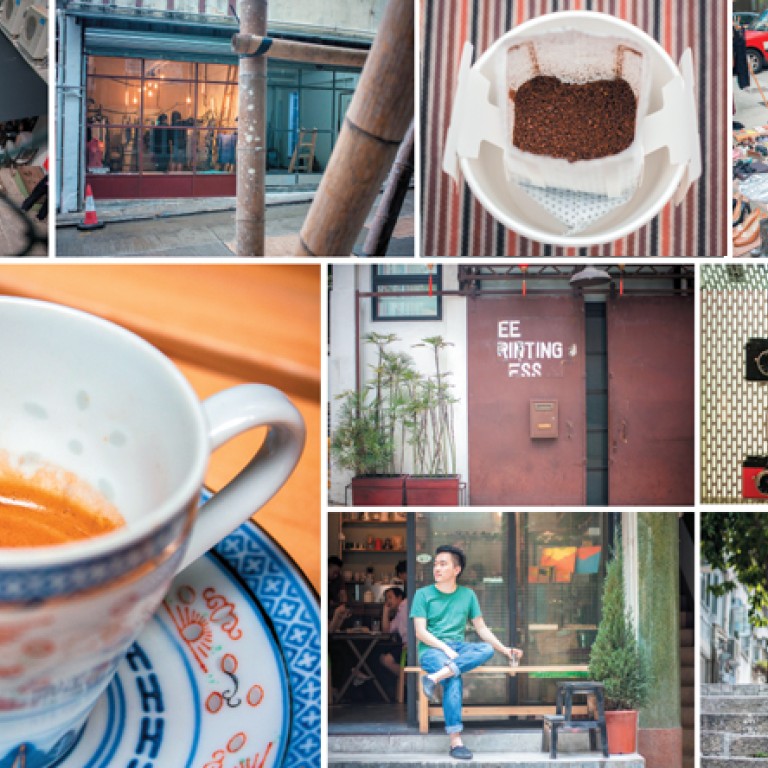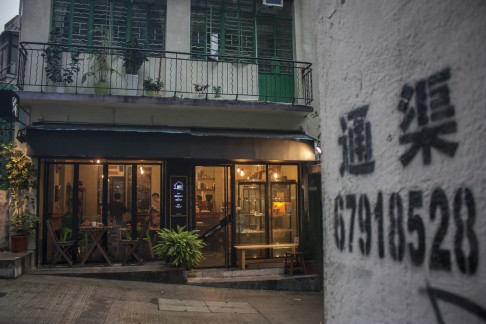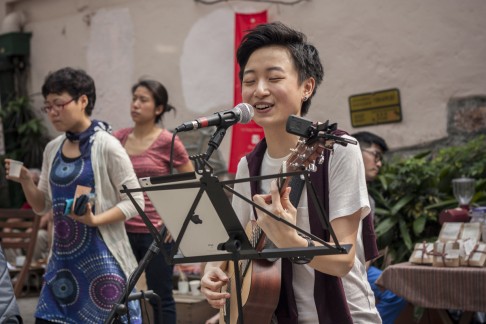
Hong Kong’s oldest neighbourhood, Tai Ping Shan, gets a makeover
Tai Ping Shan may be the oldest neighbourhood in the city, but after a facelift it looks younger than ever
FIRST SETTLED IN the 1840s, devastated by disease in the 1890s and a tight-knit working-class enclave for much of the 20th century, the area around Tai Ping Shan Street has recently become a magnet for independent shops, cafes and art galleries.
Much of the appeal has to do with its laid-back atmosphere.
“I love the Tai Ping Shan area because of its greenery, the big old trees, the low-rise neighbourhood and the old steps,” says Katty Law, who grew up on nearby Caine Road and still livesJ in the area.
“People who live and work here are mostly very friendly, probably due to the relaxed atmosphere.”
It’s an area that is changing quickly, however, thanks to gentrification and the possible construction of an escalator up Pound Lane, which has divided opinion in the neighbourhood. For now, it seems to have struck a balance between traditional and trendy and is as friendly as ever.

BREAKFAST
“This is a local roast,” says Josh Ng as he sets down a cup of espresso on the quiet steps of Shing Wong Street. Just a few years ago, this entire street was slated to be wiped out by the Urban Renewal Authority, but neighbourhood opposition and a surge of public interest following the release of Echoes of the Rainbow, which was filmed on the adjacent Wing Lee Street, put a halt to the project.
A year and a half ago, Josh and his twin brother Caleb opened Common Ground, a cosy coffee shop on the ground floor of a restored tong lau. Carefully selected beans, fry-ups and burgers dominate the menu, but it’s mainly a place to hang out, which is exactly what happens every day as patrons lounge on wood tables and benches set up on the street. “Last Sunday, there were many customers who knew each other.
It’s rare to find this kind of space in Hong Kong. People can sit around all day and we don’t give them dirty [looks].”
GALLERY HOP
When artist-run gallery Para Site opened on Po Yan Street in 1997 it was the only art space in a neighbourhood of printers, coffin makers and car mechanics. Now it has been joined by a host of other galleries. Sin Sin Fine Art, which specialises in contemporary Indonesian art, arrived on Sai Street in 2006.

One of the newest arrivals is AP Contemporary, which opened in March with a show by Korean painter Jieun Park.
Perhaps the most intriguing new development in the neighbourhood is the Liang Yi Museum, a sprawling Hollywood Road showcase of the world’s largest private collection of Chinese antique furniture. Founder Peter Fung conceived the museum as a place where visitors would be able to both look at and touch the furniture. The museum’s HK$200 admission fee includes a personal guided tour.
At the other end of the design spectrum is Droog, a cheeky Dutch brand known for its irreverent, high-concept products like the doorbell that consists of a mallet swinging between two wine glasses, or a fish tank that contains a miniature Chinese restaurant. “We do things with a twist,” says founder Renny Ramakers, who visited Hong Kong in December to open Droog’s two-storey gallery and shop on Square Street, its first outpost in Asia.

LUNCH
It has only been a few months since Nosh opened on Upper Station Street, but it already seems to have joined the likes of For Kee Restaurant (known for pork chops) and Yuk Kin (famed for fried rice) as a neighbourhood institution. The café is clearly designed with people-watching in mind — it has a minimalist black-and-white interior and is dominated by a large open window, whose long wood bar attracts passers-by to stop and chat. Chef Danielle Yuen’s frequently changing lunch menu features simple, elegant dishes with an emphasis on fresh ingredients, while pastry chef Aki Yamamoto offers delicate French pastries like tarte Tatin and madeleines.

SMART SHOPPING
Conventional wisdom says that retail shops thrive in high-traffic areas, but Tai Ping Shan’s unorthodox boutiques prove just the opposite.
“When I first came here, it didn’t feel like Hong Kong — it’s not only about making money,” says Cody Tsui, a hair stylist turned merchandiser who recently opened Mood, a barbershop boutique that stocks vintage treasures from Paris alongside classic British menswear brands.
It’s a neighbourhood that lends itself to niche shops with eclectic merchandise. Around the corner from Mood, Kwun Tong-based street artists Start from Zero have opened Rat’s Cave, a gritty lifestyle boutique that often hosts mini flea markets on the street outside. Nearby, in the back room of bakery-café Saffron, Metal Postcard Records founder Sean Hocking has opened a record store and listening room that stocks a wide variety of indie music. “It’s either mid-40s men or under-20s girls who come in — they buy Ramones or Velvet Underground records,” he says.
Down the hill is Lomography. The shop specialises in analogue Lomo cameras which are prized for their unpredictable output and toy-like appearance. “It’s a lifestyle, not just photography,” says shop manager Janas Kwok. “We organise workshops, exhibitions and outings.”

TEA TIME
Perhaps nowhere embodies the Tai Ping Shan spirit better than Teakha, a teahouse and zakka store founded by food writer Nana Chan. The carefully blended teas and house-made pastries fall on just the right side of precious; try the hojicha au lait with a yuzu financier or the masala chai with a ginger scone. Teakha recently celebrated its second anniversary with a street fair that attracted musicians and street vendors who hawked vintage clothes and locally roasted coffee.
“This is a real neighbourhood,” says designer Khanh-Linh Nguyen-Trong, who was selling “pre-loved” clothes on the street outside Teakha. “I used to live near here, and when I come back, everyone still says ‘hi’.”
What’s there
EAT/DRINK
19 Shing Wong Street, tel 2818 8318
11 Upper Station Street, tel 2559 8508
Shop J-K, 200 Hollywood Road, tel 2546 8947
Shop A, 6 Tai Ping Shan Street, tel 2549 2505
Shop B, 18 Tai Ping Shan Street, tel 2858 9185
SEE/SHOP
4 Po Yan Street, tel 2517 4620
53-54 Sai Street, tel 2858 5072
28 Tai Ping Shan Street, tel 3105 2118
181-199 Hollywood Road, tel 2806 8280
47 Square Street, tel 2893 8664
Shop A, 22 Tai Ping Shan Street, tel 2559 8308
Shop A, 18 Tai Ping Shan Street, tel 2858 9001
24 Square Street, tel 2806 2132
2 Po Yan Street, tel 2915 2205

